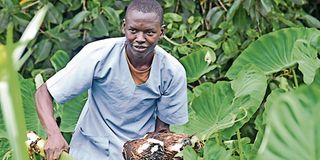Young man rewrites slum story, an arrowroot at a time

Richard Otieno harvests arrowroots in his farm in Nyalenda Slum, Kisumu County. The crop has more protein than other tropical food sources such as potatoes, cassavas and plantains. PHOTO | ELIZABETH OJINA | NATION MEDIA GROUP
What you need to know:
- The youth leader is growing mainly arrowroots in the slum on 0.7 acres, part of his parent’s land. He farms the tubers alongside bananas and indigenous vegetables.
- Arrowroots can be propagated through suckers, rootstock or rhizomes with two or more nodes each.
- They thrive in any place with enough soil moisture, which is needed for growth and development.
- He is currently working with several youth groups and training them on how to grow the crop. He supplies them with planting material to produce arrowroots.
Richard Otieno, 26, a farmer in Nyalenda slums, Kisumu County, is keen on rewriting the story of the informal settlement.
The youth leader is growing mainly arrowroots in the slum on 0.7 acres, part of his parent’s land. He farms the tubers alongside bananas and indigenous vegetables.
The Seeds of Gold team finds Otieno and his two workers growing a variety of traditional vegetables that include cow peas, saget, kanzira, and managu.
“Arrowroot is my main crop here. I have 500 stems, from which I harvested some the other week and got 16 bags of 90 kilos each that I sold in local markets,” he says.
He started arrowroot farming in November 2018 after visiting a friend’s farm in Mwea. “I was inspired by the returns he got from the venture,” says Otieno.
But that aside, “I also realised that few people grow them in Kisumu, which gave me the psyche to engage in the project.”
Otieno said he invested Sh20,000 in the business from his savings. The money helped him buy 1,000 suckers of the Dasheen variety at Sh10 each. The rest of the amount was spent on fencing the farm and on labour.
“The site is swampy, thus it is conducive for planting arrowroots. I do spacing of 30cm from one plant to another and plant the seedlings at a depth of 1.5 feet,” he says.
Arrowroots can be propagated through suckers, rootstock or rhizomes with two or more nodes each.
They thrive in any place with enough soil moisture, which is needed for growth and development.
MUCH MORE PROTEIN CONTENT
Simultaneous weeding and cultivation must be done during the first three months. The farmer had his first harvest in April last year, getting 12 (90kg) bags of arrowroots and sold each at Sh15,000.
A kilo, on the other hand, goes for Sh300. The harvest has been rising over the period, with the farmer now selling the produce through a shop he runs in Kondele, which retailers flock to pick the produce.
His biggest challenge, however, are the neighbours, some of who harvest the produce while he is away, says Otieno, who is also into performing arts and other grassroots youth activities.
“Apart from the neighbours, sometimes pigs from the area destroy the tubers while searching for worms in the swamp,” says Otieno.
He is currently working with several youth groups and training them on how to grow the crop. He supplies them with planting material to produce arrowroots.
“My plan is to establish a network of young farmers so that we can consistently supply tubers to the market,” he says.
Prof Mathew Dida of Maseno University’s Department of Agriculture says proper fencing addresses the problem of theft of the farm produce.
“Arrowroots are normally affected by pests such as leaf roller, caterpillar, arrowroot butterflies and armyworm, which can cause massive damages to the crop. Farmers should also get materials with good yield. Pick seedlings that are free of pest and diseases,” advises Prof Dida.
Arrowroot is a starch-rich rhizome with a good source of vitamin B6, vitamin C, niacin, potassium, copper and manganese.
The crop has more protein than other tropical food sources such as potatoes, cassavas and plantains.

